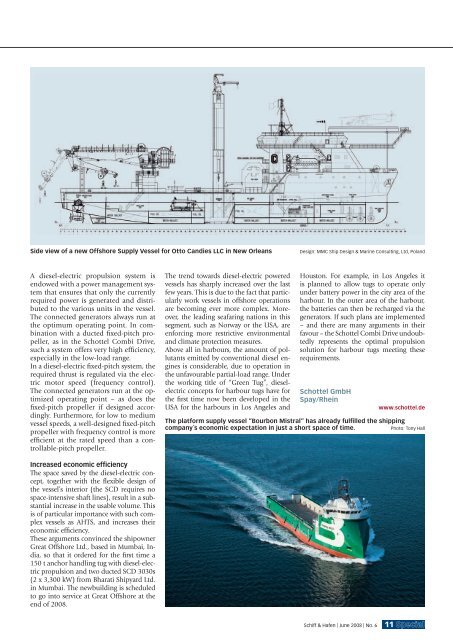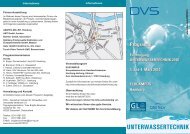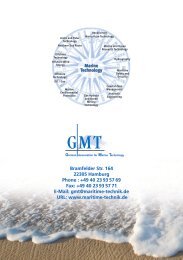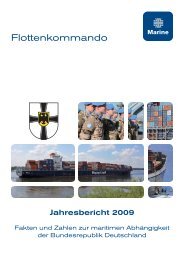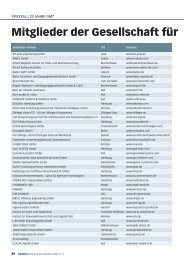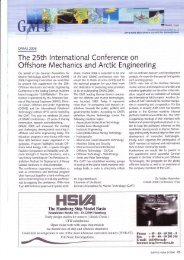Offshore Technology
Offshore Technology
Offshore Technology
Create successful ePaper yourself
Turn your PDF publications into a flip-book with our unique Google optimized e-Paper software.
Side view of a new <strong>Offshore</strong> Supply Vessel for Otto Candies LLC in New Orleans Design: MMC Ship Design & Marine Consulting, Ltd, Poland<br />
A diesel-electric propulsion system is<br />
endowed with a power management system<br />
that ensures that only the currently<br />
required power is generated and distributed<br />
to the various units in the vessel.<br />
The connected generators always run at<br />
the optimum operating point. In combination<br />
with a ducted fi xed-pitch propeller,<br />
as in the Schottel Combi Drive,<br />
such a system offers very high effi ciency,<br />
especially in the low-load range.<br />
In a diesel-electric fi xed-pitch system, the<br />
required thrust is regulated via the electric<br />
motor speed (frequency control).<br />
The connected generators run at the optimized<br />
operating point – as does the<br />
fi xed-pitch propeller if designed accordingly.<br />
Furthermore, for low to medium<br />
vessel speeds, a well-designed fi xed-pitch<br />
propeller with frequency control is more<br />
effi cient at the rated speed than a controllable-pitch<br />
propeller.<br />
Increased economic efficiency<br />
The space saved by the diesel-electric concept,<br />
together with the fl exible design of<br />
the vessel’s interior (the SCD requires no<br />
space-intensive shaft lines), result in a substantial<br />
increase in the usable volume. This<br />
is of particular importance with such complex<br />
vessels as AHTS, and increases their<br />
economic effi ciency.<br />
These arguments convinced the shipowner<br />
Great <strong>Offshore</strong> Ltd., based in Mumbai, India,<br />
so that it ordered for the fi rst time a<br />
150 t anchor handling tug with diesel-electric<br />
propulsion and two ducted SCD 3030s<br />
(2 x 3,300 kW) from Bharati Shipyard Ltd.<br />
in Mumbai. The newbuilding is scheduled<br />
to go into service at Great <strong>Offshore</strong> at the<br />
end of 2008.<br />
The trend towards diesel-electric powered<br />
vessels has sharply increased over the last<br />
few years. This is due to the fact that particularly<br />
work vessels in offshore operations<br />
are becoming ever more complex. Moreover,<br />
the leading seafaring nations in this<br />
segment, such as Norway or the USA, are<br />
enforcing more restrictive environmental<br />
and climate protection measures.<br />
Above all in harbours, the amount of pollutants<br />
emitted by conventional diesel engines<br />
is considerable, due to operation in<br />
the unfavourable partial-load range. Under<br />
the working title of “Green Tug”, dieselelectric<br />
concepts for harbour tugs have for<br />
the fi rst time now been developed in the<br />
USA for the harbours in Los Angeles and<br />
Houston. For example, in Los Angeles it<br />
is planned to allow tugs to operate only<br />
under battery power in the city area of the<br />
harbour. In the outer area of the harbour,<br />
the batteries can then be recharged via the<br />
generators. If such plans are implemented<br />
– and there are many arguments in their<br />
favour – the Schottel Combi Drive undoubtedly<br />
represents the optimal propulsion<br />
solution for harbour tugs meeting these<br />
requirements.<br />
Schottel GmbH<br />
Spay/Rhein<br />
www.schottel.de<br />
The platform supply vessel “Bourbon Mistral“ has already fulfi lled the shipping<br />
company´s economic expectation in just a short space of time. Photo: Tony Hall<br />
Schiff & Hafen | June 2008 | No. 6 11 Special


